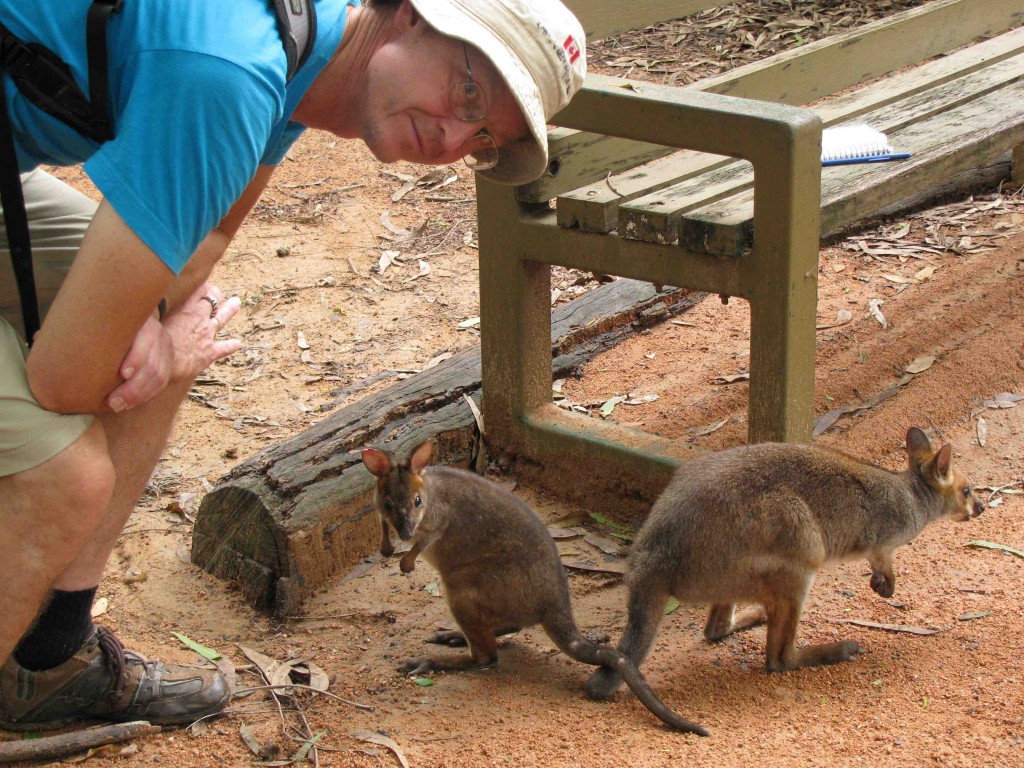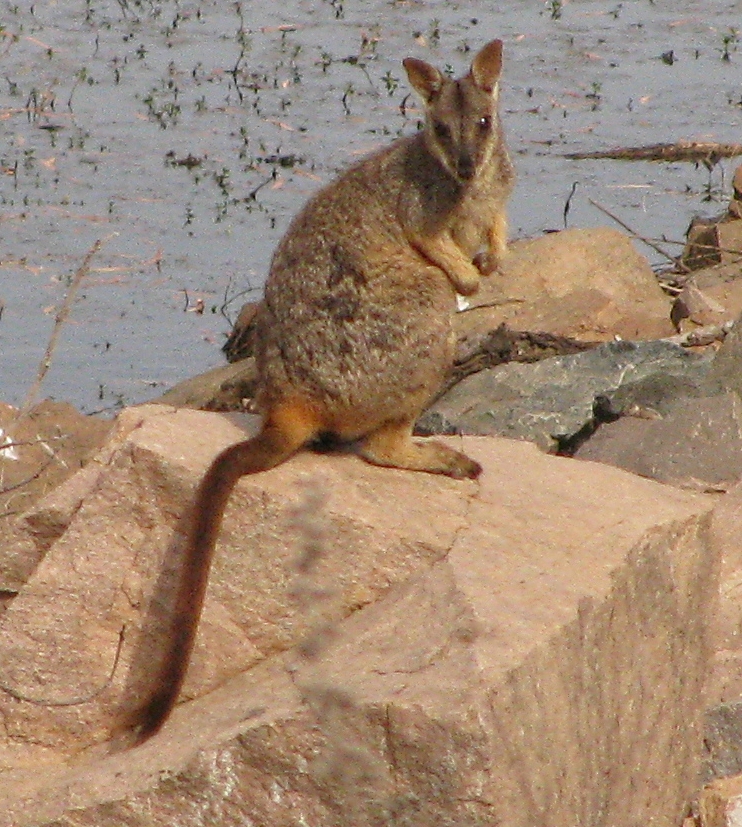
Eastern Grey Kangaroos at Hundred Mile Swamp, Undara Volcanic National Park (© Vilis Nams)
Of all Australia’s iconic animals, kangaroos are arguably the best-known around the world, their popularity perhaps enhanced by that white, stylized depiction of a roo painted on the red tails of Qantas jets. It’s common knowledge that kangaroos hop and that the females have pouches in which they carry their young, called joeys. While reading Stephen Jackson and Karl Vernes’s book Kangaroo: Portrait of an Extraordinary Marsupial, I came across less well-known and intriguing bits of information about these macropods, a name appropriately meaning ‘bigfoot’.

Vilis and Red-legged Pademelons, Billabong Sanctuary, Townsville (© Magi Nams)
First, 77 species of macropods inhabit Australia and come in a sliding scale of sizes, from ‘large’ kangaroos, to ‘medium’ wallabies, to ‘small’ roo rellies, some of which go by the most exotic names imaginable –monjon, nabarlek, quokka, mala, potoroo, bettong, pademelon. These names are derived from Aboriginal words; for example, the Eora people living in what is now the Sydney region gave us the following macropod names: betong, walaru, badimaliyan, budaru, and wallabi, which, as you probably guessed, translate to the Anglicized bettong, wallaroo, pademelon, potoroo, and wallaby. It was James Cook, illustrious captain of the Endeavour, who first noted that native people called one of the larger macropods “Kanguroo.”1

Allied Rock Wallaby, Ross River Dam, Townsville (© Magi Nams)
Kangaroos and their rellies exist throughout Australia in an astounding variety of habitats, from dense rainforests to the driest deserts, from rocky outcrops to thick heaths, or in the case of tree kangaroos, in the treetops. They are the most prominent native herbivores on the continent (just imagine no cattle, no sheep, no camels, no horses, no donkeys; in fact, no hoofs at all) and thus are the equivalent to the deer and antelopes, large rodents and monkeys of other continents. They eat grasses, tubers, seeds, truffles, fruits, insects, and the leaves of trees, digesting them in a most environmentally friendly way, in that they produce zero methane, one of the most troublesome greenhouse gases produced in abundance by cattle, for example. (There could be a strong case made here for eating kangaroo meat rather than beef, particularly since Australia appears to face a future hard-hit by global warming.)2
Roos and their rellies are, of course, hoppers par excellance. Although hopping loses out to darting on four legs when it comes to speeding up or maneuvering at low speeds, the bounds of roos moving at high speeds are resoundingly more energy-efficient than the four-legged running of other speedy species.3

Eastern Grey Kangaroo Female with Young at Foot (© Vilis Nams)
Perhaps the quirkiest tidbit of roo information I read was the fact that nearly all reproducing female macropods (excluding musky rat-kangaroos) may nourish young at three different stages of development at the same time, and with food arranged to suit. One stage is the embryo awaiting implantation in a uterus (usually delayed for a period after mating, since gestation is short and the female already has a pouch baby). Another stage is the pouch baby, first called a neonate, that appellation given to the miniscule newborn that rips out of the mambrane sac enclosing it and pulls itself up over the female’s pouch fur to a teat in the pouch or marsupium (all this action occurring within 5 minutes), where it completes its development. (The neonate of the red kangaroo, Australia’s largest macropod, is only a centimetre long and weighs less than a gram.) Yet another stage is the young at foot, the joey outside the pouch that still feeds from a specific, elongated teat within the pouch which provides it with milk having a different composition than the milk nourishing the growing neonate or pouch baby attached to a different teat. So, a female roo may have an embryo in waiting, a pouch baby, and a young at foot all at the same time and do a bang-up job of caring for them all.4
During the evening, Vilis and I attended a Christmas party with varied and intriguing foods, and with fresh winds blowing in over a spacious, elevated deck on which tables bearing the foods were stationed. City lights peppered the deep blue sky, and the silhouettes of mountain slopes rose against the oncoming night. There wasn’t a snowflake in sight.
Reference:
1. Stephen Jackson and Karl Vernes. Kangaroo: Portrait of an Extraordinary Marsupial. 2010. Allen & Unwin, Crows Nest, New South Wales, pp. xi, 1, 6-7; 2. Ibid, pp. xii, 260; 3. Ibid, pp. xiii, 151; 4. Ibid, pp. xii, xiii, 81-82, 98.


